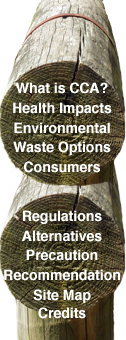Waste Options
Reuse
A UK analysis of treated wood waste streams found that the ‘Best Practicable Environmental Option’ is reuse, findings that are consistent with the principals of the waste hierarchy employed both in the UK and Australia. (Not producing the waste in the first place, is of course preferable.) However, the researchers did note that reuse markets for wood waste are limited and the value of the waste is low. Additionally, the quality of the wood waste and the risk of contamination were also cited as barriers to this option (Enviros Consulting et al, 2004). Similar research from the US found that up to 86 percent of CCA-treated timber from residential decks could be recovered for reuse (Smith et al, 2004). Yet in practice it has been found that parks and recreation facilities, in Florida at least, are concerned about the structural integrity of used CCA-treated timber, and prefer not to use it (Solo-Gabriele et al, 2000).
However, whilst reuse may deal with the waste disposal problem, it can exacerbate the health and environmental problems associated with the use of CCA-treated timber because it prolongs that use. In Florida, waste CCA-treated timber was prohibited from co-generation plants because of the resulting heavy metals in the ash but the waste was then diverted to mulch production, raising the risk to soil and groundwater through leaching (Solo-Gabriele, et al, 2001). Leachate from mulch manufactured from construction and demolition waste, which often contains waste CCA-treated timber failed water quality standards set by the US EPA (Townsend et al, 2001). And although the CSIRO highlights the potential use of CCA-treated timber as garden edging and fence posts, it warns against use of CCA-treated products being reused in mulch, animal bedding, beehives’ as well as food chopping boards and boxes used to store or transport food (CSIRO, 2002).
Researchers at Michigan State University have investigated the use of CCA-treated timber fibres in wood-cement particle composites. The resulting composite was found to have comparable strength to normal concrete and to withstand strains at peak load that are ten fold greater than normal concrete. This led the researchers to propose this material for use in energy dissipation applications (Gong et al, 2004).
USDA Forest Products researchers have found that oxalic acid extraction and bioleaching with a metal-tolerant bacterium can successfully remove up to 78 percent of copper, 97 percent of arsenic and all chromium from CCA-treated pine, which can then be recovered for reuse or disposal. It is noted that this remediation is currently ‘cost prohibitive’, but could become financially viable if landfill restrictions are imposed (Clausen and Kenealy, 2004).
Researchers from the USDA Forest Service have developed a metal-tolerant wood decay fungi to degrade waste CCA-treated timber (Illman et al, 2004). This reduces the volume of waste rather than reusing it.
References:
Clausen, C. and Kenealy, W., (2004), ‘Scaled-Up Remediation Of CCA-Treated Wood’, Topic 1: Release of Preservatives into the Environment, Conference Paper from Environmental Impacts Of Preservative-Treated Wood Conference, February 8-11, Orlando, Florida.
CSIRO (2002), ‘CCA Facts’, Commonwealth Scientific and Industrial Research Organisation website, http://www.ffp.csiro.au/wft/wpc/ccafact1.html (accessed 11/11/04).
Enviros Consulting and The BioComposites Centre, University of Wales (2004), Treated Wood Waste: Assessment of the Waste Management Challenge, The Waste & Resources Action Programme (WRAP), UK.
Gong, A., Kamdem, D., and Harichandran, R. (2004), ‘Compression Tests On Wood-Cement Particle Composites Made Of CCA-Treated Wood Removed From Service’, Environmental Impacts Of Preservative-Treated Wood Conference, February 8-11, 2004, Orlando, Florida.
Illman, B. and Yang, V. (2004), ‘Bioremediation And Degradation Of CCA-Treated Wood Waste’, Environmental Impacts Of Preservative-Treated Wood Conference, February 8-11, 2004, Orlando, Florida.
Smith, B., Bailey, D., Araman, P. (2004), ‘Characterizing Properties And Products Of Spent CCA From Residential Decks’, Poster From The Environmental Impacts Of Preservative-Treated Wood Conference, February 8-11, 2004, Orlando, Florida.
Solo-Gabriele, H., Hosein, N., Jacobi, G., Townsend, T., Jambeck, J., Hahn, D., Moskal, T., Iida, K. (2001), ‘On-Line Sorting Technologies for CCA-Treated Wood’, Draft Submitted on September 30, for Sarasota County for Submission to the FDEP Innovative Recycling Grants Program.
Solo-Gabriele, H., Kormienko, M., Gary, K., Townsend, T., Tolaymat, T. (2000), Alternative Chemicals and Improved Disposal-End Management Practices for CCA-treated Wood, Florida Center For Solid And Hazardous Waste Management, Florida.
Townsend, T., Stook, K., Tolaymat, T., Song, J., Solo-Gabriele, H., Hosein, N., and Khan, B. (2001), New Lines of CCA-Treated Wood Research: In-Service and Disposal Issues, Florida Center For Solid And Hazardous Waste Management, Florida.


